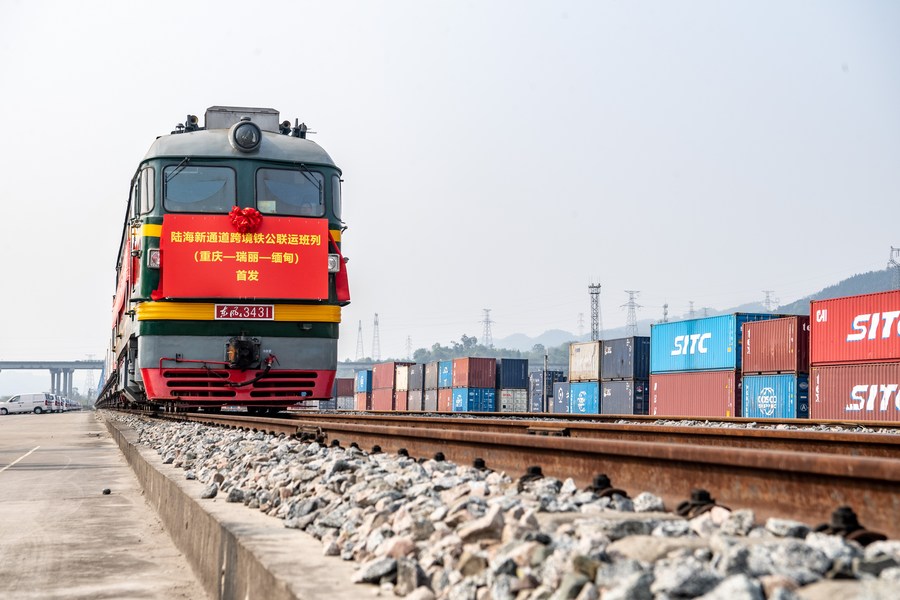Land-sea trade corridor promotes win-win cooperation along BRI

This photo taken on April 3, 2023 shows a freight train waiting for departure in the Jiangjin District of southwest China's Chongqing Municipality. The operation of the freight train marked the opening of a new transport route via the New International Land-Sea Trade Corridor. (Xinhua/Tang Yi)
CHONGQING, May 23 (Xinhua) -- Visitors at an international investment and trade fair in southwest China's Chongqing Municipality were captivated by the innovative range of new energy vehicles displayed by SERES that are set to hit the global market through the New International Land-Sea Trade Corridor.
The trade corridor is a trade and logistics passage jointly built by provincial-level regions in western China and ASEAN countries. It is also one of the key projects under the Belt and Road Initiative (BRI) initiated by China.
"Compared to the old route via river and sea, the new trade corridor can save us 10 to 20 days. It has played a crucial role for our company in expanding its footprints in the overseas markets," said Zhang Xingyan, general manager of the overseas business division of SERES Group, a carmaker based in Chongqing.
For instance, through the trade corridor, SERES' products can reach Indonesia in only about 18 days, whereas earlier it would take about a month.
As of 2022, the company has exported vehicles and auto components worth approximately 2 billion yuan (about 284.39 million U.S. dollars) through the trade corridor to many countries including Indonesia, Peru and Ecuador.
As the trade corridor provides a faster and more efficient channel with reduced transportation and operation costs, SERES has boosted its overseas investment. To date, it has invested 150 million U.S. dollars in establishing an automobile manufacturing base in Indonesia.
The rapid growth of the company exemplifies the immense opportunities provided by the trade corridor.
Thanks to the trade corridor, an increasing number of products from China's inland provinces and regions along the route, such as Ningxia Hui Autonomous Region's red wine, Luosifen, or the stinky snail noodle from Guangxi Zhuang Autonomous Region, and nuts from Xinjiang Uygur Autonomous Region, have explored broader markets worldwide.
"We saw a growing participation of Chinese provinces and regions, as well as countries and regions along the route, which showcases the fundamental principle of attaining shared growth through consultation and collaboration," said Liu Wei, director of the logistics and operation coordination center of the New International Land-Sea Trade Corridor.
Four years ago, the trade corridor linked 166 ports in 71 countries, but it has now expanded to include over 390 ports across 119 countries.
Laotian redwood furniture, Philippine durians and Indonesian civet coffee can reach Chongqing through the trade corridor in just a few days.
Wu Yang, who has long been engaged in the transportation business between China and Laos, hailed the trade corridor for significantly reducing transportation time. "It would take more than 20 days to transport goods from Laos to China's western hinterland in Chongqing and Sichuan. Thanks to the trade corridor, the transportation time has been cut to four days," Wu said.
The trade corridor serves as a vital link between Asia and Europe, making substantial contributions to regional economic development and integration. Its impact is particularly noteworthy in ensuring secure supply chains for essential raw materials such as food, feed, chemicals, fertilizers and energy, said Ahmad Parveez Hj Ghulam Kadir, director general of Malaysian Palm Oil Board.
"We are going to further strengthen our operational and organizational capacity, improve the infrastructure networks, deepen integrated innovation and reform of institutions, and promote the profound integration of transportation, logistics and the economy," Liu said.
According to Zhai Kun, a professor at the School of International Studies, Peking University, the trade corridor's progress not only reflects the resilience, potential and vitality of China's economy but also embodies the concept of a community with a shared future for humanity, which affirms the far-sightedness of the BRI.


